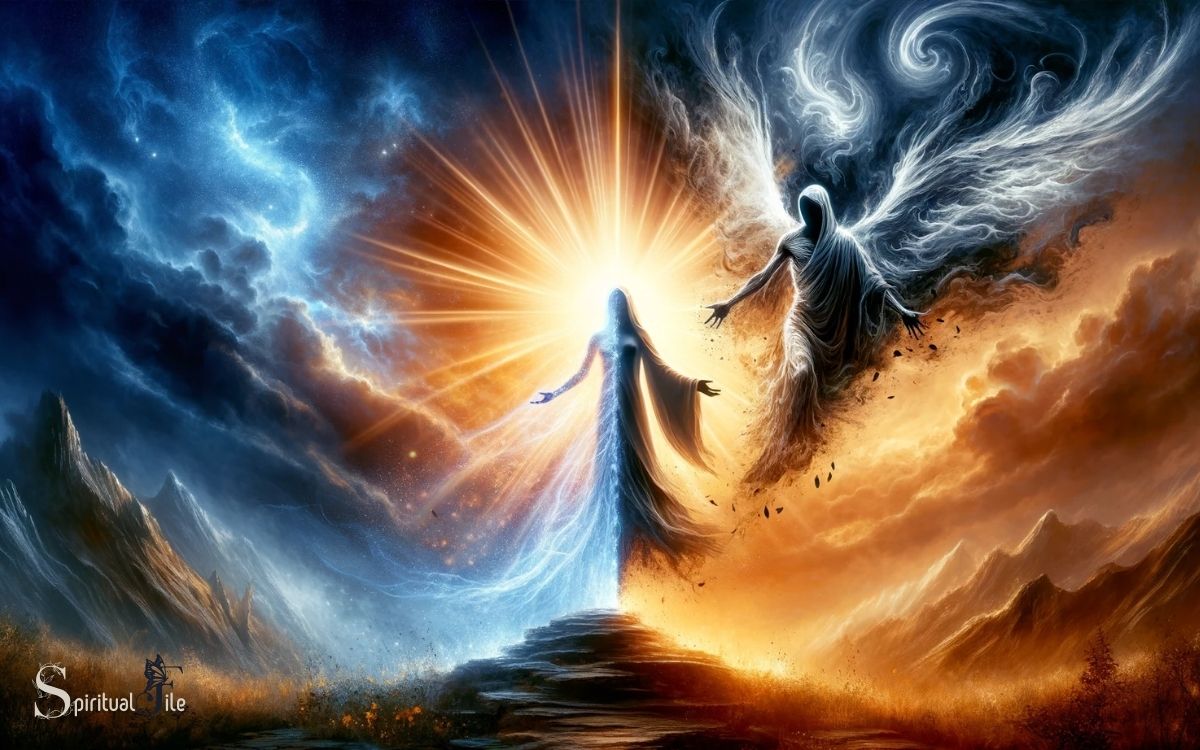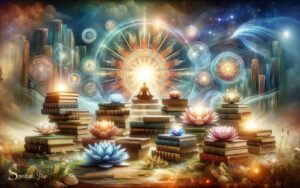Spiritual Battle Between Good and Evil: Love!
The concept of a spiritual battle between good and evil is a prevalent theme across various religions, mythologies, and philosophical beliefs.
It often portrays life as a battlefield where forces of goodness, representing virtues like love, compassion, and truth, are in perpetual conflict with forces of evil, symbolized by hatred, greed, and deception.
Individuals and societies are seen as participants in this cosmic struggle, with personal actions and choices influencing the balance between these opposing powers.
The narrative of a spiritual battle between good and evil serves to contextualize moral and ethical decisions within a larger framework of cosmic significance.
It can be found in:
For example, in Christianity, this battle is epitomized by the struggle between God and Satan, where followers are encouraged to put on the “armor of God” to resist evil (Ephesians 6:11).
The spiritual battle between good and evil compels individuals to reflect on their moral choices, often inspiring acts of courage and benevolence in the face of adversity.

Key Takeaway
Origins of the Conflict
As I ponder the origins of the conflict between good and evil, it becomes clear that this battle has been waged since the beginning of time.
The concept of good and evil is deeply rooted in the human experience, reflecting our struggle to understand the forces that shape our world.
Many belief systems and philosophies attribute the origins of this conflict to the dichotomy of human nature, where the capacity for both good and evil resides within each individual.
Others attribute it to supernatural entities or cosmic forces locked in eternal opposition. Regardless of the specific origin, the conflict between good and evil serves as a moral compass, guiding individuals and societies in their quest for justice, compassion, and righteousness.
Understanding the origins of this conflict can shed light on the complexities of human nature and the perennial pursuit of harmony and virtue.
Archetypal Forces at Play
As we explore the archetypal forces at play in the spiritual battle between good and evil, we encounter the universal cosmic struggle that transcends cultures and time periods.
We also come face to face with the concept of Jungian shadow integration, where the battle within ourselves mirrors the larger conflict in the world.
Furthermore, the mythic hero’s journey emerges as a timeless narrative that reflects the eternal battle between these opposing forces.
Universal Cosmic Struggle
The universal cosmic struggle between archetypal forces is a timeless theme that resonates across cultures and belief systems. It reflects the eternal battle between good and evil, light and darkness, creation and destruction.
This profound concept transcends religious dogma and speaks to the very essence of human existence. It is the embodiment of the ongoing conflict within ourselves and the world around us.
The archetypal forces at play represent the fundamental aspects of the human psyche, symbolizing our deepest fears, desires, and aspirations.
Understanding this universal struggle offers profound insights into the human experience, providing a framework for navigating the complexities of life.
By recognizing and engaging with these archetypal forces, we can strive for greater self-awareness, personal growth, and the realization of our highest potential.
Jungian Shadow Integration
While delving into the depths of my own psyche, I’ve encountered the powerful interplay of archetypal forces at play, guiding me through the process of Jungian Shadow Integration.
This journey has been both enlightening and challenging, as I’ve grappled with understanding and integrating the various aspects of my shadow self.
Here are some key insights I’ve gained:
- Awareness: Recognizing the existence of my shadow self has been the first step towards integration.
- Acceptance: Embracing the darker aspects of myself without judgment has been crucial for achieving inner harmony.
- Integration: Actively working to understand and integrate the shadow has led to a sense of wholeness and balance within myself.
- Transformation: Engaging with my shadow has allowed me to harness its energy for personal growth and positive change.
Mythic Hero’s Journey
Embarking on the Mythic Hero’s Journey, I’ve encountered the persistent interplay of archetypal forces, guiding me through a profound exploration of self-discovery and transformation.
This journey has revealed the universal patterns of human experience, as I faced trials and tribulations, confronted my deepest fears, and ultimately emerged transformed.
The archetype of the hero’s journey has provided a framework for understanding my own struggles and growth, resonating with the collective unconscious and offering profound insights into the human condition.
As I navigate this mythic terrain, I find myself confronting archetypal forces such as the mentor, the threshold guardian, and the shadow, each playing a crucial role in shaping my path.
Through this lens, I’ve come to understand the timeless nature of these archetypes and their profound impact on our individual and collective narratives.
Symbolism in Myths and Legends
As I ponder the significance of myths and legends, I am drawn to the powerful symbolism they hold. These ancient tales are rich with cultural symbols that carry profound meanings and lessons.
Exploring the symbolism in myths and legends allows us to uncover the timeless truths embedded within these narratives.
Symbolism in Ancient Myths
I’m fascinated by the complex symbolism present in ancient myths and legends, which often serves as a representation of deeper spiritual truths. The use of symbols in ancient myths helps convey profound ideas and universal themes.
Here are four fascinating aspects of symbolism in ancient myths:
- Archetypal Symbols: These symbols, such as the hero, the trickster, and the wise old man, represent fundamental human experiences and characteristics.
- Nature Symbols: Ancient myths often use elements of nature, like the sun, moon, and animals, to convey deeper meanings and connections to the natural world.
- Cultural Symbols: Symbols specific to certain cultures carry rich historical and spiritual significance, reflecting the values and beliefs of ancient civilizations.
- Cosmic Symbols: Myths frequently incorporate symbols related to the cosmos, such as stars, constellations, and the heavens, to explore the mysteries of existence and the divine.
Legends and Cultural Symbols
There’s a rich tapestry of cultural symbols woven into ancient myths and legends, each carrying profound significance and reflecting the values and beliefs of diverse civilizations.
These symbols often serve as a means of communicating complex ideas and moral lessons in an easily digestible form.
For instance, the serpent, a prevalent symbol in many myths, represents both malevolent and benevolent forces in different cultures, signifying wisdom, fertility, and temptation.
Similarly, the motif of the hero’s journey is a universal symbol of personal growth and triumph over adversity found in myths worldwide.
Understanding these symbols provides insight into the shared human experiences and the timeless themes of good and evil that permeate our collective consciousness.
Spiritual Warfare in Religious Texts
One can find compelling accounts of spiritual warfare in various religious texts, revealing the eternal struggle between good and evil. As I have studied these texts, I’ve come to understand the depth and complexity of this spiritual battle.
Here are some profound insights I’ve gained:
- The Bhagavad Gita: The epic battle between good and evil is depicted as an internal struggle within the protagonist, Arjuna, symbolizing the inner conflicts we face.
- The Bible: The book of Ephesians describes spiritual warfare as a struggle against evil forces in the heavenly realms, emphasizing the need for spiritual armor and readiness.
- The Quran: It portrays the ongoing battle between believers and the forces of darkness, highlighting the importance of faith, prayer, and perseverance.
- The Tibetan Book of the Dead: This text discusses the journey of the soul through different spiritual realms and the battles it faces before reaching enlightenment.
These texts provide valuable insights into the nature of spiritual warfare and the strategies for overcoming evil. Understanding these concepts can help us navigate our own spiritual battles and strive for goodness in our lives.
The Human Experience of Good and Evil
Experiencing the constant tug between good and evil has been a profound and challenging aspect of my personal journey. It’s a struggle that permeates every facet of life, from the small, everyday decisions to the larger, moral dilemmas.
The human experience of good and evil often feels like a battle within oneself, where the lines between right and wrong can blur. It’s a struggle that requires constant reflection, self-examination, and the courage to make choices that align with our values.
At times, the pull towards self-interest and immediate gratification can cloud our judgment, making it difficult to discern the right path.
On the other hand, acts of kindness, empathy, and compassion remind us of the innate goodness within us. Understanding this internal conflict is crucial in navigating the complexities of human nature and morality.
Contemporary Perspectives on the Battle
Navigating the complexities of human nature and morality, I find that contemporary perspectives on the battle between good and evil reveal an ongoing struggle within our collective consciousness.
Here are some key observations that shed light on our current understanding:
- Moral Relativism: Many people now view morality as subjective, leading to a blurred line between good and evil.
- Psychological Insights: Understanding of human behavior and motivations has brought attention to the intricate interplay between good and evil within individuals.
- Social Media Influence: The digital age has amplified the visibility of both virtuous acts and malevolent deeds, shaping our perception of good and evil.
- Cultural Diversity: With globalization, diverse cultural beliefs and values have sparked discussions on the universality of good and evil.
As we grapple with these contemporary perspectives, it becomes evident that finding balance and harmony amidst such complexities is essential for our spiritual well-being.
Finding Balance and Harmony
Striving for balance and harmony in the spiritual battle between good and evil requires constant introspection and mindfulness. It’s essential to acknowledge that both good and evil exist within each of us.
Finding balance means recognizing and managing these conflicting forces within ourselves. I’ve found that practicing mindfulness, meditation, and self-reflection helps me stay centered and aware of my thoughts and actions.
It’s also important to surround myself with positive influences and engage in activities that promote spiritual growth. By doing so, I create a harmonious environment that supports my journey towards goodness.
Additionally, being mindful of my choices and their potential impact on others allows me to contribute positively to the collective battle between good and evil. This ongoing effort to find balance and harmony within myself is a crucial aspect of my spiritual journey.
Conclusion
As the sun sets on the horizon, the eternal battle between good and evil rages on within our souls.
The forces of light and darkness clash like waves against the shore, but in the end, it is up to each of us to find balance and harmony within ourselves.
Just as the moon and stars illuminate the night sky, may we strive to illuminate our own paths with the light of goodness, love, and compassion.






